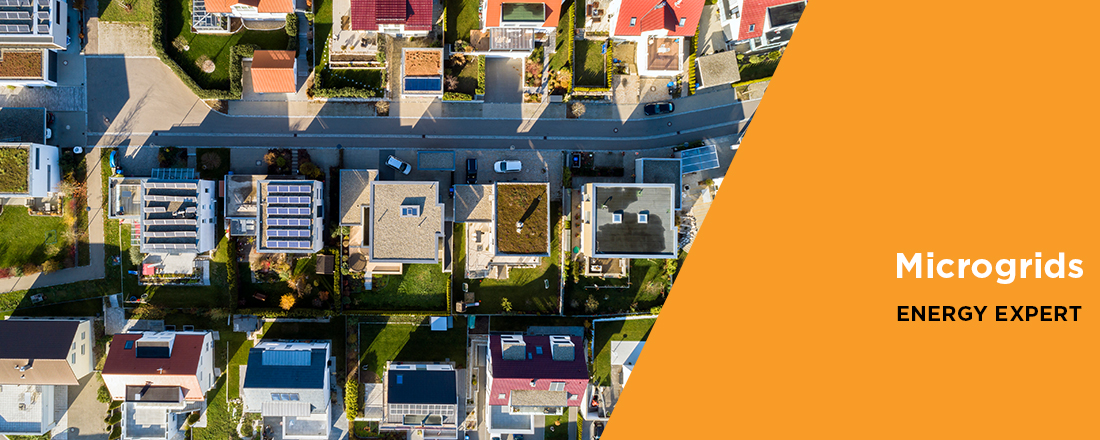MCE’s Energy Expert Series takes a deeper dive into more complex energy topics like the development of the duck curve and the nuts and bolts of Net Energy Metering. Go behind the scenes with our Energy Expert series or read more in our Energy 101 series.
As wildfires and extreme weather events increase, more customers are looking for solutions that provide greater energy resiliency. Energy resiliency is any energy system that allows customers to access power even when the electrical grid isn’t operating, like during a storm, wildfire, or Public Safety Power Shutoff event. You can address energy resiliency in many ways, including a solar panel and a battery in your home, a portable backup battery that’s charged when the power is on, or a large system known as a microgrid.
Microgrids are any local sources of generation and energy storage that can be disconnected from the larger energy grid to provide energy to a single facility or to a group of buildings or homes. When the main power grid goes down, microgrids allow the connected buildings to maintain power. Microgrids are most often seen on campus-type facilities, such as research institutions or universities.
How Does a Microgrid Work?
A traditional electric grid connects a vast number of facilities to a variety of centralized power generation sources through long-distance electric transmission lines. Power is generated and transported through these lines to where it’s needed. This centralized system has benefited customers by providing access to large, lower-cost forms of electric generation. However, when the grid goes down, everyone connected to it loses power. You can learn more about how electricity services work in our Energy Basics blog.
In contrast, microgrids operate in tandem with the traditional electrical grid, but they can be isolated and operated on their own if the main electrical grid is down. This alternative power requires local generation sources, such as solar paired with battery storage. The resources that are used to create a microgrid may vary, but what’s unique about them is their ability to provide backup power to the connected facilities, often using clean generation sources.
How Much Does a Microgrid Power?
The size of a microgrid can vary significantly and can be small to power just one facility or much larger to include an entire campus or neighborhood. A microgrid isn’t defined by its size; rather it’s defined by its ability to be isolated from the grid and its localized generation sources that provide power to the entire area they cover. Microgrids are typically used in areas where a power outage could be harmful to those using the facility or the work that occurs there, such as research facilities, military bases, emergency operations (police and fire stations), and hospitals.
How long a microgrid can operate independently from the main electrical grid depends on the type and size of generation and on the energy storage resources that are used. If the system is designed appropriately, a microgrid can run for extended periods of time¾days, weeks, or even longer.
What Are the Benefits of Microgrids?
- Energy Resiliency: The most notable benefit of microgrids is the ability to maintain power during a grid outage, so that vulnerable populations who require access to power can stay in their homes. Examples of vulnerable populations include individuals who depend on electricity for medical or independent living needs and those who can’t afford to relocate, even temporarily. Energy resiliency is also relevant for small businesses that may lose revenue during an outage due to a decrease in customers or due to a lack of refrigeration for perishable items. Whatever the circumstance, increasing energy resiliency helps keep people safe in their homes and reduces the economic burden.
- Energy Cost Savings: The nature of microgrids requires local generation such as solar, which is available when the sun is shining, not just during an outage. Solar generation can lower your energy costs by reducing the amount of electricity being purchased from the grid. Microgrids are beneficial in larger facilities with high electricity bills and in underserved communities, where electricity costs are generally a disproportionally high percentage of monthly expenses.
- Clean Energy: Microgrids operate by using clean energy such as solar or wind paired with energy storage. Clean energy is the best resource for localized generation because it doesn’t produce air pollution. Increased use of clean energy is not only good for our planet, but it’s also good for our health. Reducing particulate matter in the air can help reduce rates of childhood asthma and other respiratory illnesses.
- Energy Independence: Another notable benefit of a microgrid is the ability to control your electricity supply. Energy independence is a growing movement that’s helping communities take back control of their climate impacts and future health. By utilizing a microgrid, a community or facility can control their energy bills, the type of power they’re using, and the emissions associated with their electricity use.
How Do I Get a Microgrid in My Community?
The process of building a microgrid can be a complicated and expensive process. In early 2021, the California Public Utilities Commission issued a decision on microgrid development in the state of California. This decision included the creation of a $200 million Microgrid Incentive Program that allows critical facilities owned by public agencies and located on adjacent properties to supply power to one another during grid outages. These exciting changes allow the creation of more microgrid resiliency centers, which can provide resources to vulnerable customers during power outages.
Over time, microgrids are likely to become a much larger part of our energy landscape. MCE is working diligently to support installation of battery backup in critical facilities and the homes of vulnerable customers throughout our service area. These resources will help reduce electricity bills and increase energy resiliency and the use of clean energy in our service area. Stay tuned for more updates on microgrids and more content in our Energy Expert series.






